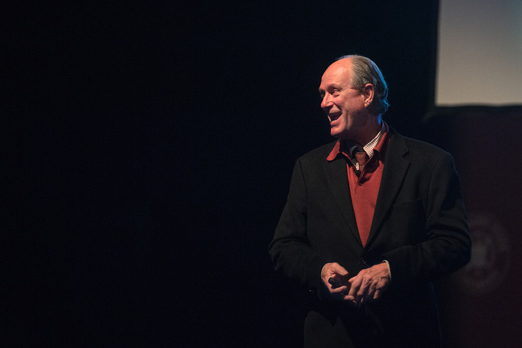Legendary undersea explorer Robert Ballard: ‘I’m not done’
Contact: Sasha Steinberg

STARKVILLE, Miss.—From British passenger ships Titanic and Lusitania and Nazi German battleship Bismarck to World War II U.S. aircraft carrier Yorktown and John F. Kennedy’s PT-109 torpedo boat, Robert Ballard has dedicated his life to underwater archaeological expeditions that have located numerous iconic shipwrecks.
When one of the world’s most accomplished oceanographers is asked what he considers his greatest discovery, he offers an interesting response.
“I don’t know what my greatest discovery is because I don’t know what out’s there; I’m not done. Our bodies eventually fail us, but our spirit is indestructible,” the 75-year-old Ballard told his Mississippi State audience during a Wednesday [Feb. 7] evening program in historic Lee Hall’s Bettersworth Auditorium.
Sponsored by the MSU Student Association, Ballard’s “The Last Frontier” presentation was the latest in the organization’s Global Lecture Series.
A self-described “underwater cowboy,” Ballard said the Mid-Ocean Ridge is a favorite locale in his extensive exploration career. Ringing Earth like the seam of a baseball, the mountain range covers 23 percent—or more than one quarter—of the Earth’s total surface area.
“It’s the single largest feature on our own planet, and it’s here where the Earth creates its outer skin,” Ballard said. “No one had actually gone down to the boundary of creation until a group of us got in submarines.”
What did Ballard and his fellow divers find in the “valley of creation?”
“All along it are these volcanoes,” Ballard said. “We were trying to understand why the Mid-Ocean Ridge was a positive feature under tension. When we got to the ridge itself, it was hot but not hot enough. It was missing heat. We found out that there’s a totally separate circulation system on the planet we didn’t know about. The entire volume of the ocean is going inside Earth and out through this system,” he explained.
Ballard said he and fellow explorers also discovered massive deposits of copper, lead, silver, zinc and gold on 72 percent of the Earth.
Additionally, Ballard discussed his role in discovering hydrothermal vents. Living around the vents, he said, are 13-foot long tubules that ingest a poisonous gas known as hydrogen sulfide.
“Around these tubules were massive clams, and when we dissected the clams, they had no mouth, no digestive system, no internal plumbing. They looked like clams, but didn’t have the internal anatomy of clams,” Ballard explained.
A cyanobacteria living in the gut of the clams oxidizes hydrogen sulfide and fixes carbon, Ballard said.
“We found an independent life system on our planet living not off the energy of the sun, but the energy of the Earth itself. That was a pretty cool discovery.” Ballard is a 1974 University of Rhode Island marine geology doctoral graduate who served in the U.S. Navy for more than 30 years. He is best known for the 1985 discovery of the sunken R.M.S. Titanic.
“Thresher and Scorpion were two (U.S.) submarines that the Navy lost in the Cold War. It was actually mapping these two ships that taught me how to find the Titanic because I learned that I needed to look for its debris field,” said Ballard, who would go on to find more than 55 shipwrecks.
Beyond serving as a National Geographic Society explorer-in-residence, Ballard also directs the University of Rhode Island’s Center for Ocean Exploration and is president of Ocean Exploration Trust, which he founded in 2008.
With a mission of engaging in pure ocean exploration, the Ocean Exploration Trust’s international programs center on scientific exploration of the seafloor, with many expeditions being launched from aboard Ballard’s 64-meter research vessel Nautilus. The ship’s name pays homage to the vessel operated by Captain Nemo in “20,000 Leagues Under the Sea,” the novel by Jules Verne that inspired his passion for becoming a marine geologist.
Ballard and his team regularly invite educators and students of all ages aboard during Nautilus expeditions, offering hands-on experiences in ocean exploration, research and communications. For more, visit http://nautiluslive.org.
Ballard’s team of explorers is referred to as the “Corps of Exploration.” As he has mandated, the group will be comprised of “55 percent women in positions of leadership and authority, and the corps will reflect the faces of our nation—the United Shades of America.”
“A child needs to see their face in our corps,” Ballard emphasized. “They see their face, and they know there’s no ceiling. There’s none in ours.”
Learn more about the MSU Student Association and its Global Lecture Series at www.sa.msstate.edu or follow on Twitter and Instagram @MSU_SA.
MSU is Mississippi’s leading university, available online at www.msstate.edu.